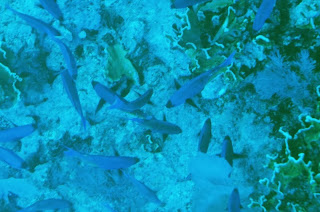Our grandson Ryan, besides being a precocious naturalist, is also a budding photographer. Here is his portrait of Grandpa, Grandma, Uncle Davin and Auntie Adrienne on t.e beach at the John Pennekamp Coral Reef State Park on Key Largo, uppermost of the Florida Keys, on December 9, 2012. We are there to take Ryan on an adventure.
I don't know why it is, but small children seem endlessly fascinated with fish. Ryan is no exception, except that he wants to know the name of every one he sees. I could think of nothing he would enjoy more than one of the glass-bottom boat trips out to the reef at Pennekamp (I'll try him on snorkeling when he's older, I hope - perhaps on one of the reefs of his home in Malaysia).
Laughing Gulls (Larus ridibundus) accompanied us on our trip out to the reef.
Once we got there, we headed down into the hold to see what was about.
Photographing fishes through the well of a glass-bottom boat is a frustrating experience, and my results are nothing to brag about, but here are a few examples of what Ryan saw. These are Creole Wrasse (Clepticus parrae), a common schooling fish on the reef, identifiable by the blackish smudge on their snouts.
Another Creole Wrasse swims over a gently waving sea fan, probably a Common Sea Fan (Gorgonia ventalina) - for those who don't know, sea fans are soft corals and therefore colonial animals, not plants (or fans).
Yellowtail Snappers (Ocyurus chrysurus) are abundant (and outside protected areas, heavily fished).
I don't know why it is, but small children seem endlessly fascinated with fish. Ryan is no exception, except that he wants to know the name of every one he sees. I could think of nothing he would enjoy more than one of the glass-bottom boat trips out to the reef at Pennekamp (I'll try him on snorkeling when he's older, I hope - perhaps on one of the reefs of his home in Malaysia).
Laughing Gulls (Larus ridibundus) accompanied us on our trip out to the reef.
Once we got there, we headed down into the hold to see what was about.
Photographing fishes through the well of a glass-bottom boat is a frustrating experience, and my results are nothing to brag about, but here are a few examples of what Ryan saw. These are Creole Wrasse (Clepticus parrae), a common schooling fish on the reef, identifiable by the blackish smudge on their snouts.
Another Creole Wrasse swims over a gently waving sea fan, probably a Common Sea Fan (Gorgonia ventalina) - for those who don't know, sea fans are soft corals and therefore colonial animals, not plants (or fans).
Yellowtail Snappers (Ocyurus chrysurus) are abundant (and outside protected areas, heavily fished).
A party of grunts swims over Elkhorn coral (Acropora palmata), one of the main Caribbean reef-building corals. I'm not positive, but I think these are White grunt (Haemulon plumieri).
One of the most ubiquitous of all reef fishes is the Sergeant-Major (Abudefduf saxatilis).
Finally, this, I think, is a Black Grouper (Mycteroperca bonaci).
Back on the beach after all the underwater excitement, we spent some time looking at birds...
...In particular, at some quite tame Ruddy Turnstones (Arenaria interpres) doing their own examination of the beach.
For the best look at birds in the Upper Keys, though, it pays to drive down US#1 to the Florida Keys Wild Bird Center, a rescue and rehabilitation centre that draws in a fair number of wild birds hoping to share in the bounty. It was our next stop.
The hangers-on around the rehab cages were less numerous than I have seen on past visits, but included Great Egrets (Ardea alba)...
...and rows of hopeful Turkey Vultures (Cathartes aura).
We finished our day with a scroll down to the mangroves at the edge of the key, where White Ibises (Eudocimus albus) stood quietly among the mudflats...
...and Brown Pelicans (Pelecanus occidentalis) tended to their plumage, perched on exposed coral boulders just offshore.
It made a lovely end to a memorable day for Ryan - and for the rest of us, too.



+DSC_5808.jpg)
+DSC_5810.jpg)
+DSC_5816.jpg)








+DSC_5884.jpg)
+DSC_5894.jpg)

+DSC_5897.jpg)
+DSC_5920.jpg)
+DSC_5915.jpg)
+DSC_5917.jpg)
+DSC_5925.jpg)
+DSC_5899.jpg)
+DSC_5902.jpg)


+DSC_5907.jpg)

No comments:
Post a Comment